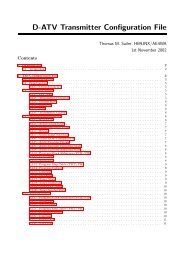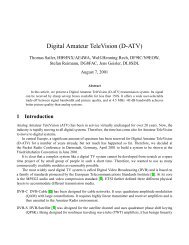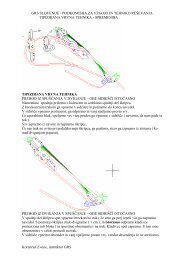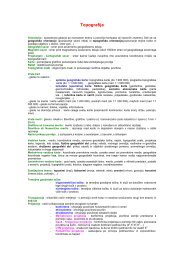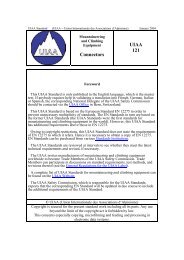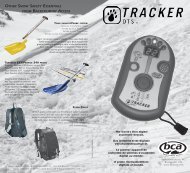A Newsletter for Friends of the CAIC
A Newsletter for Friends of the CAIC
A Newsletter for Friends of the CAIC
- No tags were found...
You also want an ePaper? Increase the reach of your titles
YUMPU automatically turns print PDFs into web optimized ePapers that Google loves.
A <strong>Newsletter</strong> <strong>for</strong> <strong>Friends</strong> <strong>of</strong> <strong>the</strong> <strong>CAIC</strong>Winter 2006 ! Volume 10, Number 2What a difference one year can make.Last winter <strong>the</strong> San Juan Mountains <strong>of</strong>sou<strong>the</strong>rn Colorado saw one <strong>of</strong> <strong>the</strong>irbiggest snowfalls in years while <strong>the</strong> centraland nor<strong>the</strong>rn mountains struggled to reachaverage. This year <strong>the</strong> nor<strong>the</strong>rn mountains <strong>of</strong> Coloradoare on a pace to see one <strong>of</strong> <strong>the</strong>ir best winters in decades,while <strong>the</strong> San Juan’s are struggling to rise above 80% <strong>of</strong>normal. We all know <strong>the</strong> fickle nature <strong>of</strong> wea<strong>the</strong>r so wedon’t want to count on a banner spring season up northjust yet. Although that can be hard,especially as <strong>the</strong> snow piles up by<strong>the</strong> foot in my front yard justsouth <strong>of</strong> Breckenridge. Today, I ambasking in <strong>the</strong> glow <strong>of</strong> a wonderfulday <strong>of</strong> light powder snow found on<strong>the</strong> north aspect <strong>of</strong> Baldy. Thestash remains a secret as <strong>the</strong>re areeasily a dozen Baldy mountains inColorado.Our prime mission at <strong>the</strong> <strong>CAIC</strong> isto reduce <strong>the</strong> impact <strong>of</strong> avalancheson <strong>the</strong> people <strong>of</strong> Colorado. Ourgoal each year is to record a seasonwith no avalanche fatalities. Of course <strong>the</strong> easiest wayto do that would be to have no snow. That opens awindow to <strong>the</strong> nightmare <strong>of</strong> drought, so <strong>the</strong>re has to bea balance <strong>of</strong> wishes, needs and wants. Water is <strong>the</strong>lifeblood <strong>of</strong> our state. Across <strong>the</strong> west, no snow meanszero avalanches accidents, but it also means no water.So we get through <strong>the</strong> blizzards, deal with snarledtraffic, and enjoy <strong>the</strong> recreational opportunities our stateenjoys. The big snows signal ano<strong>the</strong>r summer withwater in our reservoirs, that’s a very good thing.Un<strong>for</strong>tunately it also means avalanches, and so far, thathas been a bad thing.I’ve had some trouble getting this Powder Stash ontopaper. Our first avalanche fatality <strong>of</strong> <strong>the</strong> seasonoccurred on November 6th. Serious early season avalancheaccidents are not uncommon in Colorado. Theexcitement <strong>of</strong> a new winter tied toge<strong>the</strong>r with <strong>the</strong> lure<strong>of</strong> early season snows <strong>of</strong>ten lead to powder vision. Atfirst I thought I’d lead <strong>the</strong> Powder Stash with a review<strong>of</strong> that accident. Then, just be<strong>for</strong>e Christmas, Decemberby Scott Toepfer, Editor22nd, two climbers turning back from Grays Peak, afourteener on <strong>the</strong> Continental Divide in nor<strong>the</strong>rnColorado, were caught in a natural slide on <strong>the</strong> east side<strong>of</strong> Kelso Peak. An 18 year old was killed. This one washard, two young men made <strong>the</strong> right decision to turnback in deteriorating wea<strong>the</strong>r conditions. If <strong>the</strong>y werefive minutes faster or slower on <strong>the</strong>ir descent, it wouldhave been nothing more than a close call. Fatalities arealways hard on our staff, but especially over a holiday.The new-year did not start on a good note. Two morepeople were killed in a hard slabavalanche near Cameron Pass,west <strong>of</strong> Fort Collins. Four fatalitiesin our first two months <strong>of</strong> operations,was <strong>the</strong>re something extraordinarilydangerous about this year’ssnowpack? Do <strong>the</strong> odds stack upagainst us if we keep putting morepeople into <strong>the</strong> mountains? Are<strong>the</strong>re better ways <strong>for</strong> us to get ourproduct out to <strong>the</strong> people using <strong>the</strong>backcountry? These are all questionswe’ve been asking ourselvesthis winter. At all <strong>of</strong> our staff meetings,we’ve been reviewing <strong>the</strong> what, how, when andwhere <strong>of</strong> our avalanche <strong>for</strong>ecasts. We’ve looked at whato<strong>the</strong>r <strong>for</strong>ecast centers are doing across <strong>the</strong> west, andeven in Europe, where avalanche accidents are muchmore common. As <strong>the</strong> <strong>CAIC</strong> continues, we will striveto find answers to <strong>the</strong> questions that snow and avalanchesbring to Colorado. So expect a better <strong>CAIC</strong> astime goes on.We’re just like every o<strong>the</strong>r business in Colorado; <strong>the</strong>reare constraints on <strong>the</strong> program. There’s <strong>the</strong> limitedbudget, if we open in October, we’ll have to close inMarch. Early season wea<strong>the</strong>r and snowpack data can befairly limited too, as most ski areas are still closed, andour remote wea<strong>the</strong>r stations are not up and running yet.Then <strong>the</strong>re’s Mo<strong>the</strong>r Nature, lightning has a way <strong>of</strong>imploding expensive wea<strong>the</strong>r instrumentation perchedon exposed ridges during late fall thunder storms. Tryingto determine when winter will arrive is at best an educatedguess. What happens if we schedule our openingcontinued on page twoThe Beacon, Winter 2006 ! Volume 10, Number 2 1
Powder Stashcontinued from page oneon December first, and we get an early start like we did this year?Until we find a way to work our budget to support <strong>the</strong> full season,we’ll be faced with this conundrum. Let’s hope this rash <strong>of</strong> accidentshas run its course. O<strong>the</strong>rwise, it will be a long winter.So on to better news, let’s turn to this issue <strong>of</strong> The Beacon.Included in this second issue <strong>of</strong> <strong>the</strong> season, are <strong>the</strong> usual widevariety <strong>of</strong> articles. We’re always looking <strong>for</strong> field data. We <strong>of</strong>tenget e:mail reports from friends and o<strong>the</strong>r backcountry travelersabout what <strong>the</strong>y saw on <strong>the</strong>ir days tour. We encourage <strong>the</strong>sereports, you are our eyes and ears in <strong>the</strong> mountains <strong>of</strong> Colorado.Andy Gleason has written a short piece on things that we reallylook <strong>for</strong> in <strong>the</strong>se reports. Timing is everything, if you can get usgood in<strong>for</strong>mation asap, we’ll put out a better product. It’s assimple as that.Last year <strong>the</strong> San Juan Mountains saw a couple <strong>of</strong> back to backstorm and avalanche cycles <strong>of</strong> near historical impact. OurSilverton intern, Susan Hale was <strong>the</strong>re and has written a personalaccount <strong>of</strong> <strong>the</strong> experience. It’s a hard article to put down. We’vealso included a short bio on our newest <strong>for</strong>ecaster (from last year),Spencer Logan. He’s got a pretty impressive resume, and eventhough he’s not that old in years, <strong>the</strong>re’s a chance he’s shoveledmore snowpits than all <strong>of</strong> us combined.Finally, Knox submitted a remembrance <strong>of</strong> a woman I had <strong>the</strong>good luck to have met on a couple <strong>of</strong> occasions, Sue Ferguson.Sue died last December from cancer. She lost her long fight withthis terrible disease, and even though we all knew she faced avery difficult battle, we were all greatly saddened by her passing.Both Sue and I shared a great love <strong>of</strong> glaciers, and <strong>for</strong>tunately,she left a legacy <strong>of</strong> avalanche research and glacier knowledgethat we will always be able to review. So put those snow shovelsaway <strong>for</strong> a bit, sit down and take a load <strong>of</strong>f, and enjoy yourBeacon. !BackcountryObservationsby Andy Gleason, Forecaster, <strong>CAIC</strong>-BoulderIn Colorado, we issue avalanche <strong>for</strong>ecasts from a central locationin Boulder. We rely on accurate and timely observationsfrom a network <strong>of</strong> backcountry and ski area observers. Weintegrate <strong>the</strong> observations that come into <strong>the</strong> Boulder <strong>of</strong>fice toproduce an avalanche <strong>for</strong>ecast <strong>for</strong> <strong>the</strong> entire state <strong>of</strong> Colorado. Ifyou, as a backcountry user, can send us observations about <strong>the</strong>snowpack and wea<strong>the</strong>r in your area, it can only help us create abetter <strong>for</strong>ecast and help to prevent avalanche accidents. Folkshave asked us if we want observations from “Lay-skiers”. Theanswer is an enthusiastic YES! The more observations we receive,<strong>the</strong> better in<strong>for</strong>mation we can include in <strong>the</strong> <strong>for</strong>ecasts. Don’tworry if your particular observation is not on <strong>the</strong> hotline, restassured it was still used to create <strong>the</strong> <strong>for</strong>ecast.The best way to send in your in<strong>for</strong>mation is via email atcaic@qwest.net. You can also call in your observations at 303-499-9650. The following are a few guidelines <strong>for</strong> observationsthat will help us make better <strong>for</strong>ecasts.Avalanche ObservationsThese are observations <strong>of</strong> recent avalanches that you have seenor triggered. Timing is everything. Old avalanche data helps fillour data base, but it’s <strong>the</strong> recent activity we need to broadcast. Ifyou see activity, let us know as soon as you can. The key points inavalanche reports are location, aspect, elevation, and slope angle.If <strong>the</strong>re are multiple avalanches, estimate <strong>the</strong> number you’veseen. The size <strong>of</strong> <strong>the</strong> fracture line, and width and length <strong>of</strong> <strong>the</strong>avalanches help us out, but are difficult to estimate from long distances.If you are familiar with avalanche classification, you cansend us a coded avalanche observation. If you would like to learnmore about how to describe avalanches check out <strong>the</strong> new Snow,Wea<strong>the</strong>r, and Avalanches: Observational Guidelines (SWAG) <strong>for</strong>Avalanche Programs in <strong>the</strong> United States, a publication <strong>of</strong> <strong>the</strong>American Avalanche Association (AAA). You can read <strong>the</strong> SWAGon <strong>the</strong> AAA website at http://www.avalanche.org/~research/guidelines/.Snowpack ObservationsThese include snow observations that help a <strong>for</strong>ecaster sittingin Boulder to get a clear picture <strong>of</strong> how <strong>the</strong> snowpack is reactingin your area. Things to include: shooting cracks, collapses,whumphs, ski or foot penetration, wind slabs, wind loading andwet snow. Please also include <strong>the</strong> location, aspect, elevation, andslope angle <strong>of</strong> where you were.Snow pits should be representative <strong>of</strong> avalanche starting zonesin <strong>the</strong> area, but should be dug in safe areas. Snow pits are great,but if you didn’t write up a <strong>for</strong>mal pit, let us know how deep it isto a specific weak layer. If you notice a prominent and persistentweak layer, report <strong>the</strong> depth from <strong>the</strong> surface, <strong>the</strong> type <strong>of</strong> snowabove it and <strong>the</strong> aerial extent. What are <strong>the</strong> snow surface conditions?They may not be contributing to <strong>the</strong> hazard now, but howwill new snow bond to <strong>the</strong> surface snow? Is <strong>the</strong> surface wet, dry,faceted, wind slab, ice-crust, or low-density powder?Any observations you make such as shooting cracks, collapses,whumpfs etc… should include <strong>the</strong> location <strong>of</strong> <strong>the</strong>se observationswith aspect, elevation and slope angle. Include pertinent negativessuch as no cracking or no movement on steep slopes too. Ifyou report a stability test, be sure to include what kind <strong>of</strong> test youconducted, <strong>the</strong> aspect, elevation and slope angle. You can alsoinclude shear quality in<strong>for</strong>mation.Here’s an example <strong>of</strong> a good concise report:Jill Outabounds, 12-21-05, 11:30 am. It is 22 degrees F with aSW wind at 10–20 mph. It has been snowing moderately (S1) <strong>for</strong>2 hours. I saw a HS-N-R2-D2-S on a NE, 32-degree slope at12,400’ in <strong>the</strong> San Juan range on Mt. Abrams. Fracture line 2–4ft deep, width 300’, vertical fall 1200’. The slope was wind loadedwith about 2 feet <strong>of</strong> new snow. We had shooting cracks andwhumpfing on NE to NW slopes between 10,000 and 11,500’.South facing slopes were wind scoured. A hasty pit on a NE, 27degree slope at 11,000’ showed surface hoar at a depth <strong>of</strong> 15”below new wind loaded snow. A compression test had CT-11 at15”, Q-1. No o<strong>the</strong>r failures in a snowpack 5’ deep. We skiedlower angle slopes on a north aspect and had good riding withsnowboard penetration <strong>of</strong> about 1 foot.If you want, feel free to tell us just how good <strong>the</strong> riding reallywas. We promise not to get too jealous. !2The Beacon, Winter 2006 ! Volume 10, Number 2
Avalanches andMonkey Businessby Susan Hale, Intern, <strong>CAIC</strong>-SilvertonThere was tension in <strong>the</strong> voices heard over <strong>the</strong> crackle <strong>of</strong> <strong>the</strong>radio—between <strong>for</strong>ecasters and <strong>the</strong> highway’s regionalCDOT teams. Then, Jerry’s succinct words, “we’re in fullconditions here, boys and girls…,” gave <strong>the</strong> first hint that wemight be witnessing a once-in-a-lifetime storm. It was 11:00 pmJanuary 8th, 2005, and it would be an understatement to say itwas a stormy night. Forecaster Mark Rikkers was in one truckracing south towards Molas Pass, while lead <strong>for</strong>ecaster, JerryRoberts, and his visiting side-kick, Tim Lane, were headed <strong>the</strong>opposite direction up Red Mountain Pass. Both teams werechecking on <strong>the</strong> rapidly deteriorating road conditions andincreasing avalanche hazards threatening U.S. Highway 550, <strong>the</strong>north/south life-line <strong>of</strong> southwestern Colorado.That night after an already long day <strong>of</strong> shooting, I was allowedto stay behind and supposedly catch up on much needed sleep.The night was sleepless none<strong>the</strong>less. Around here we make ahabit <strong>of</strong> snuggling with our Motorolas, as no avalanche <strong>for</strong>ecasterworth <strong>the</strong>ir Pisco Sours would be sleeping when it’s dumpingnearly 3 inches per hour on a continental snowpack. So <strong>the</strong>re I lay,wide awake, eavesdropping.Using radio call names, Jerry Roberts anxiously tried to reachMark Rikkers.Jerry: 3 Mary 5-1 this is 3 Mary 5-0 what’s your 20?Mark: Hey Jer. This is 3 Mary 5-1. I finally made it to MolasPass—really bad visibility. What’s happening your direction?Jerry: Mark, I’m with a crazy woman stuck in a snow bank near<strong>the</strong> Muleshoe turn (below a particularly nasty avalanche path).We’ll need help getting her out so we can shut this highwaydown. Can’t reach <strong>the</strong> Red Mountain plow driver. Can you tryradioing from your location and send him our way?Mark: 10-4. I’ll give it a try.I can hear that Mark is also having trouble reaching a plowdriver. The radio reception is sketchy at both locations. So, trolling<strong>for</strong> something to do, I ventured an earnest call to Jerry, knowingit was probably a mistake.Susan: Uhh, 3 Mary 5-0, this is 3 Mary 5-2, is <strong>the</strong>re anything Ican do from here?Jerry pauses, and with <strong>the</strong> whole world listening and a stormpuking 3 inches an hour, replies.Jerry: Thanks 5-2. Uhh yea. When we get this lady out we’ll beescorting her back to Silverton <strong>for</strong> <strong>the</strong> night, but she might not beable to find a place to stay. She doesn’t speak very good English.I think she’s Romanian. You think she could camp on your s<strong>of</strong>a <strong>for</strong><strong>the</strong> night?I paused suspiciously.Susan: Uhh, yea, sure, I guess so.Jerry: Great! There is one o<strong>the</strong>r thing. I think she’s from <strong>the</strong>circus, and I think she has a monkey with her.A long pause preceded my bewildered response.Susan: Did you say MONKEY?Jerry, with Tim tittering in <strong>the</strong> background: Yea, I think it’s amonkey. Will your dog be OK with that?Of course, <strong>the</strong> Romanian Circus Woman and her monkey nevermaterialized, having been created, or so I thought, on behalf <strong>of</strong>my rookie status and over-enthusiasm. Shortly <strong>the</strong>reafter, bothroads out <strong>of</strong> Silverton were closed. Eventually Red Mountain Passmade national news, remaining closed <strong>for</strong> seven long days.That night marked <strong>the</strong> apex <strong>of</strong> what would be <strong>the</strong> biggeststorm cycle that most Silvertonians could remember. Snowfallrates, storm snow and water amounts, and avalanche numberspushed <strong>the</strong> record-books to new extremes <strong>for</strong> <strong>the</strong> month <strong>of</strong>January. Late in <strong>the</strong> evening, Highway 550 over Red Mountainand Coal Bank Passes was eventually cleared <strong>of</strong> all traffic. The<strong>CAIC</strong>-Silverton Forecast Office posted <strong>the</strong> avalanche hazard levelat a very rare EXTREME. No one, nei<strong>the</strong>r <strong>for</strong>ecaster nor plowdriver, was allowed on <strong>the</strong> road. Mo<strong>the</strong>r Nature had finally <strong>for</strong>ced<strong>the</strong> road to close so she could rage privately; avalanches don’t likepeople watching.THE BEGINNINGAn avalanche cycle doesn’t occur just because a large amount<strong>of</strong> snow falls in a short amount <strong>of</strong> time. Our continental snowpackand any resulting avalanches are shaped by a season <strong>of</strong> wea<strong>the</strong>revents. As <strong>the</strong> winter progresses, each wea<strong>the</strong>r event is tracked,recorded and catalogued by wea<strong>the</strong>r and avalanche <strong>for</strong>ecasters.By watching <strong>the</strong> snow and wea<strong>the</strong>r each day, avalanche <strong>for</strong>ecasterscan recognize <strong>the</strong> potential <strong>for</strong> a big avalanche cycle.However, predicting <strong>the</strong> duration and intensity <strong>of</strong> an individualsnow storm or avalanche cycle remains hazardous to <strong>the</strong> ego.Memories can be short and many years <strong>of</strong> drought can cloudone’s judgment. One thing remains constant; Mo<strong>the</strong>r Nature canbring <strong>the</strong> unexpected.continued on page fourOne <strong>of</strong> our backcountry observers, Scott Messina,was honored this past summer with <strong>the</strong> Greg MaceAward. Each year this award is given to individuals<strong>for</strong> <strong>the</strong>ir outstanding service to <strong>the</strong> Aspen community. Scott,a Denver native, moved to Aspen in 1986 where he landeda job as a caretaker <strong>for</strong> <strong>the</strong> 10th Mountain Division hutsystem. This job entailed hiking or skiing to all <strong>of</strong> <strong>the</strong> 10thMountain huts both summer and winter to do basic maintenance.Along with housing, he was paid 30 dollars perweek. Some people would say that 30 dollars per week isnot going to get you far in Aspen, but Scott said “Life isgood”. Scott also joined Mountain Rescue Aspen (MRA)that same year after being practically ordered to by <strong>the</strong>nMRA (Mountain Rescue Aspen) director Jim Ward. Scott stillleads training <strong>for</strong> MRA, and still does hut work <strong>for</strong> <strong>the</strong> 10thMountain huts. Greg Mace co-founded MRA with JimWard. “Greg’s grandfa<strong>the</strong>r settled in <strong>the</strong> Upper CastleCreek Drainage in 1947” said Amos Mace, Greg’s nephew.“It’s quite an honor that 20 years after Greg’s death, <strong>the</strong>community still presents this award to an esteemed volunteer.”Greg died in a climbing accident on <strong>the</strong> Maroon Bellsin July 1986.Scott owns Aspen Alpine Guides which leads clients into<strong>the</strong> backcountry. “Scott gives back more than he takes from<strong>the</strong> mountains…” said a statement released by <strong>the</strong> awardcommittee. Former award winners include such Aspen iconsas Fritz Benedict in 1987, Fred Braun in 1986, Eve Homeyerin 1989 and Claire Sanderson in 1993.After <strong>the</strong> award presentation Scott said “Holy cow—it’spretty overwhelming to receive this award. And it’s incrediblyoverwhelming when you look at <strong>the</strong> names <strong>of</strong> <strong>the</strong>people preceding me up <strong>the</strong>re. It’s a very humbling honor.”The staff at <strong>the</strong> <strong>CAIC</strong> extends large congratulations to Scott<strong>for</strong> this award. Scott, I have one follow-up question. Didyou ever find <strong>the</strong> pine marten? !The Beacon, Winter 2006 ! Volume 10, Number 2 3
Monkey Businesscontinued from page threeSTORM 1Our big wea<strong>the</strong>r/avalanche cycle consisted <strong>of</strong>three distinct storms. The first arrived on December29th, at <strong>the</strong> end <strong>of</strong> a long stretch <strong>of</strong> snow-weakeningcold and mostly dry wea<strong>the</strong>r. These conditions helpweak layers to <strong>for</strong>m near <strong>the</strong> surface <strong>of</strong> <strong>the</strong> snowpack.The result is a rotten foundation <strong>for</strong> future snows toland upon.The first in this series <strong>of</strong> southwesterly stormsarrived fast and furious and set <strong>the</strong> pace <strong>for</strong> <strong>the</strong> firsthalf <strong>of</strong> January. It began with a bully layer <strong>of</strong> slipperygraupel (a precipitation particle that looks like a smallStyr<strong>of</strong>oam ball) that was soon topped with heavy wetsnow. This was accompanied by sustained wind averagesin <strong>the</strong> 30’s and gusts reaching a whopping 90+mph. As <strong>the</strong> storm unfolded, we anticipated that 1.5to 2 inches <strong>of</strong> water would kick <strong>of</strong>f a natural avalanchecycle, and it did. By late that Wednesday afternoon,we had received 2 inches <strong>of</strong> snow water equivalentin less than 24-hours. That led to four naturaland seven mitigated avalanches hitting <strong>the</strong> road over RedMountain Pass. The Molas/Coal Bank side <strong>of</strong> Highway 550 sawfour natural and three mitigated avalanches reach <strong>the</strong> highwaycenterline. Spot road closures <strong>for</strong> avalanche mitigation andcleanup finally evolved to a full closure <strong>of</strong> <strong>the</strong> passes. Mo<strong>the</strong>rNature’s wrath <strong>of</strong> high winds, high precipitation rates andapproaching darkness declared, “You are not <strong>the</strong> boss <strong>of</strong> me!”The road remained closed until 4 pm <strong>the</strong> next day. The stormdumped <strong>the</strong> most snow on Molas Pass. We measured 21 inches<strong>of</strong> snowfall and 2.85 inches <strong>of</strong> water in just over 24-hours.STORM 2With only a few days to catch up, a second strong Pacific stormarrived late on January 3rd. Once again <strong>the</strong> wind averaged 30mph with gusts reaching into <strong>the</strong> mid 70’s. These were perfectconditions <strong>for</strong> transporting large amounts <strong>of</strong> snow into our avalanchestart zones. Temperatures were warm and thus <strong>the</strong> snowwas heavy. As <strong>the</strong> snowfall reached 2 inches an hour, <strong>the</strong>re wasano<strong>the</strong>r natural avalanche cycle and Red Mountain Pass closedagain. It didn’t open <strong>for</strong> ano<strong>the</strong>r 43-hours. Natural and mitigatedavalanches put as much as 15 feet <strong>of</strong> snow on <strong>the</strong> road. This time<strong>the</strong> Coal Bank study plot won <strong>the</strong> “most snowfall” prize, with 35inches <strong>of</strong> snow and over 3 inches <strong>of</strong> snow water equivalent. Withlarge amounts <strong>of</strong> new snow and water, high winds and a weakunderlying snowpack, we had all <strong>the</strong> ingredients <strong>for</strong> an avalanchecycle. Once we got back on <strong>the</strong> road we saw <strong>the</strong> remains <strong>of</strong>natural avalanches on all aspects. However, much to our dismay<strong>the</strong> snow in many <strong>of</strong> our larger paths remained intact. We hadhoped that more <strong>of</strong> <strong>the</strong> avalanche paths would “clean out.” Thecurrent wea<strong>the</strong>r pattern was <strong>for</strong>ecast to continue, and as <strong>the</strong> loadon our weak snowpack continued to climb, we could feel <strong>the</strong>pressure <strong>of</strong> <strong>the</strong> situation build.BIG STORMThe wea<strong>the</strong>r pattern did continue. Two days later, a superstormmoved into <strong>the</strong> San Juan Mountains from <strong>the</strong> southwest.The last storm <strong>of</strong> our record breaking cycle began Friday January7th, and battering <strong>the</strong> region through <strong>the</strong> following Wednesday.This last storm came crashing down upon us, snowing an inch anhour or more <strong>for</strong> six days. The initial wave <strong>of</strong> snow was low indensity, but as <strong>the</strong> storm continued <strong>the</strong> snow became wet andPowder cloud from East Riverside path reaches Highway 550. (Photo: Gary King)heavy. This is a classic “upside-down” snow storm and a textbookscenario <strong>for</strong> an avalanche cycle. Strong southwest winds, gustinginto <strong>the</strong> 60’s, compounded <strong>the</strong> situation. In <strong>the</strong> wee hours <strong>of</strong>January 8th, our most reliable per<strong>for</strong>mer, <strong>the</strong> Blue Point avalanchepath, put three feet <strong>of</strong> snow across 40 feet <strong>of</strong> <strong>the</strong> centerline. Soonafterward, an avalanche in <strong>the</strong> East Riverside path released.Dragging <strong>the</strong> snow from adjacent paths in its wake, <strong>the</strong> avalancherumbled down into <strong>the</strong> Ironton Gorge. These slides covered <strong>the</strong>road with four feet <strong>of</strong> snow. Later in <strong>the</strong> storm, <strong>the</strong>se paths wouldavalanche again and actually pack <strong>the</strong> only avalanche shed covering<strong>the</strong> highway with three feet <strong>of</strong> snow.On <strong>the</strong> Coal Bank side, an avalanche in <strong>the</strong> Henry Brown pathcovered <strong>the</strong> road with some <strong>of</strong> <strong>the</strong> o<strong>the</strong>r paths quickly joining <strong>the</strong>fray. With darkness nipping at our heals, wind and snowfallquickly moved snow back into <strong>the</strong> start zones as we completed<strong>the</strong> avalanche mitigation work. Dangerous travel conditions andsanity finally won out, and by 11:00 pm <strong>the</strong> north and south sections<strong>of</strong> Highway 550 out <strong>of</strong> Silverton were closed. As <strong>the</strong> mo<strong>the</strong>r<strong>of</strong> all storms continued, <strong>the</strong> monstrous avalanche paths flowingdown from peaks high above Red Mountain Pass and County Rd110 defied all “control”. The roads remained closed <strong>for</strong> sevenlong days.Our next day <strong>of</strong> work began early on <strong>the</strong> morning <strong>of</strong> January9th. While conducting avalanche hazard mitigation we used both<strong>the</strong> Avalauncher (an explosive delivery system designed <strong>for</strong> avalanchework), and brought out our WWII era artillery, a 105 mmHowitzer. We concentrated our ef<strong>for</strong>ts on <strong>the</strong> passes south <strong>of</strong>Silverton, hoping to open one escape route from <strong>the</strong> town. But inspite <strong>of</strong> all <strong>the</strong> fire-power, frustration became <strong>the</strong> <strong>the</strong>me <strong>of</strong> <strong>the</strong>day with only a few avalanches releasing. While wea<strong>the</strong>r andsnowpack conditions certainly validated <strong>the</strong> previous night’s decisionto close <strong>the</strong> roads, we still expected big “results” to validateour <strong>for</strong>ecast. Un<strong>for</strong>tunately, <strong>the</strong> most action was caused by afrightened big-horn sheep that kicked <strong>of</strong>f a series <strong>of</strong> small slides in<strong>the</strong> East Lime Creek path while we were shooting West Lime.We eventually worked our way back to Silverton, tails tuckedbetween our legs. We had managed to get <strong>the</strong> Coal Bank side <strong>of</strong>Highway 550 open. I was happy because this meant my husbandcould high-tail it home from Durango and help shovel snow.There was enough daylight <strong>for</strong> one attempt to open RedMountain Pass. Disappointed with our progress, we geared up <strong>for</strong>one set <strong>of</strong> Howitzer shots on <strong>the</strong> Red Mountain side.4The Beacon, Winter 2006 ! Volume 10, Number 2
It was late in <strong>the</strong> day, everyone was tired, cold and grumpy.After little action on Coal Bank Pass, <strong>the</strong>re were no expectations<strong>of</strong> seeing significant results from <strong>the</strong> final shoot <strong>of</strong> <strong>the</strong> day. So <strong>of</strong>fwe went, CDOT crew and <strong>for</strong>ecasters dragging <strong>the</strong> Howitzer andan entourage <strong>of</strong> bored observers from <strong>the</strong> newspaper andPrescott College students. Our plan was to shoot <strong>the</strong> Battleship,one <strong>of</strong> <strong>the</strong> most notorious slide paths leading up towards RedMountain Pass from Silverton.At 12,400 feet, <strong>the</strong> wind-loaded, 35 degree start zones <strong>of</strong> <strong>the</strong>Battleship rise nearly 3000 feet above <strong>the</strong> Mineral Creek Gorge.Between <strong>the</strong> bottom <strong>of</strong> <strong>the</strong> path and <strong>the</strong> highway area gorge and 300 feet <strong>of</strong> elevation gain. One mightsurmise that a 300 foot rise and a river gorge wouldadequately buffer <strong>the</strong> highway from <strong>the</strong> runout <strong>of</strong> anavalanche. Like many assumptions, this one wouldtoo prove to be wrong. The <strong>for</strong>ces and speedsinvolved in a full-path release in <strong>the</strong> Battleship are sogreat that <strong>the</strong> avalanche can climb up <strong>the</strong> oppositeside and deposit as much as five feet <strong>of</strong> snow on <strong>the</strong>road. The wind blast alone can cause severe damage,hurling large trees across <strong>the</strong> pavement. While anumber <strong>of</strong> folks in <strong>the</strong> crew had seen <strong>the</strong> Battleshiprun, few were prepared <strong>for</strong> what <strong>the</strong>y were about toBattleship reachesfull throttle(Photo: Ann Melick)witness. We lobed one lonely Howitzer round intoone <strong>of</strong> <strong>the</strong> Battleship’s start zones. The shot shattered<strong>the</strong> enormous slab and sent a full depth, full path,Tasmanian Devil racing down <strong>the</strong> mountainside. After<strong>the</strong> dust settled, our guests giggled in amazementand we made our way home satisfied that our perception <strong>of</strong> <strong>the</strong>avalanche danger had been correct.In this business, we like to say that “close calls are not acceptable.”I can still recall, upon my initial arrival into Silverton, Jerry’slitany <strong>of</strong> dos and don’ts on <strong>the</strong> topic <strong>of</strong> “being safe out <strong>the</strong>re” and“drama” avoidance: who to ski with, who not to ski with, who totalk to, who not to talk to, and even who to drink with! Whe<strong>the</strong>rthis was “sage” advice or flat-out gossip, it was never takenlightly. But <strong>the</strong>n <strong>the</strong>re are extraordinary situations, extraordinarystorms, and that’s when extraordinary things happen, in spite <strong>of</strong>our conservative mantra.And so it snowed, and snowed and snowed, inches per hour.While <strong>the</strong> Red Mountain side <strong>of</strong> Highway 550 was lockeddown by massive avalanches, <strong>the</strong> Coal Bank/Molas side was keptopen even though it actually received <strong>the</strong> most snowfall from thissou<strong>the</strong>rn storm (between January 8th and <strong>the</strong> morning <strong>of</strong> January11th <strong>the</strong> Coal Bank Study Site had already received 63 inches <strong>of</strong>snow that equaled 6.5 inches <strong>of</strong> water). Highway 550 south <strong>of</strong>Silverton has fewer massive paths that threaten <strong>the</strong> road. For thisreason <strong>the</strong>re was a valiant ef<strong>for</strong>t by all (CDOT crew and <strong>the</strong> <strong>CAIC</strong><strong>for</strong>ecasters) to keep this artery into Silverton open as long as possible.At this time <strong>the</strong>re had already been one health related emergencyevacuation.By January 11th, seemingly endless avalanche mitigation measureshad become dangerously mundane. Nearly 100 rounds <strong>of</strong>explosives were used on <strong>the</strong> Molas/Coal Bank side <strong>of</strong> Highway550. Would it ever stop? Would we ever sleep? As <strong>the</strong> day grewlong, visibility became poor and <strong>the</strong> race was on to get one lastset <strong>of</strong> avalauncher shots <strong>of</strong>f at <strong>the</strong> paths closest to town, <strong>the</strong>Jenny Parkers and Peacock. Vehicles, including one fully loadedfuel tanker bound <strong>for</strong> <strong>the</strong> one Silverton gas station, backed up on<strong>the</strong> road waiting to be cleared to drive down into town. While <strong>the</strong><strong>for</strong>ecasters, Jerry and Mark, and <strong>the</strong> CDOT crew were setting up.CDOT managers, Dennis McCoy and Paul DeJulio, made a lastminute decision to escort that group <strong>of</strong> vehicles carefully downinto Silverton be<strong>for</strong>e our shoot. Once <strong>the</strong>y were moved to safety,Dennis turned around to make one last pass up <strong>the</strong> road to insurethat <strong>the</strong> road was indeed clear. Driving on instinct in near zero visibility,Dennis got “up-close and personal” with an avalanchecoming out <strong>of</strong> <strong>the</strong> Harley Short path. With one hand on <strong>the</strong> wheeland <strong>the</strong> o<strong>the</strong>r on <strong>the</strong> radio, Dennis had <strong>the</strong> presence <strong>of</strong> mind tocall out “Guys, I think it’s time to shut her down!” Dennis madehis way back up to Molas Pass be<strong>for</strong>e he realized his truck wasover-heating. He cautiously crossed over Coal Bank Pass. There hewas able to coast downhill to <strong>the</strong> Cascade CDOT Barn where hediscovered a broken fan-belt caused by dense snow packed intohis radiator and engine compartment.After Dennis’ close call, <strong>the</strong> avalauncher team also decided itwas time to cut <strong>the</strong>ir losses and bail <strong>of</strong>f <strong>the</strong> mountain.Heading back toward town, <strong>the</strong>y found <strong>the</strong>mselvestrapped between two paths that ran in rapid succession.Blocked to <strong>the</strong> south by slides from <strong>the</strong> Peacockand Jenny Parker paths, <strong>the</strong>y turned to find <strong>the</strong> roadto safety and Silverton blocked by <strong>the</strong> GladstoneTwins. The “twins” are two narrow paths that dropon to Highway 550 just south <strong>of</strong> Silverton. Afteryears with few avalanches, large trees had grown in<strong>the</strong> paths. Although <strong>the</strong>y were still listed as avalanchepaths, <strong>the</strong>y were no longer considered much <strong>of</strong> athreat. That day 100 year old trees were splintered,and several nervous hours were passed while aCDOT crew used heavy equipment to clear a paththrough <strong>the</strong> debris and allow <strong>the</strong> group to return toSilverton. This series <strong>of</strong> events began <strong>the</strong> longestclosure <strong>of</strong> Coal Bank and Molas Passes during thisstormy period. They were closed <strong>for</strong> 51 hours, andwe finally got a little sleep.Already blanketed with 6–7 feet <strong>of</strong> snow, <strong>the</strong> town <strong>of</strong> Silvertonwas abuzz with activity. Plows piled enormous rows <strong>of</strong> goopdown <strong>the</strong> center <strong>of</strong> Greene Street obscuring buildings on ei<strong>the</strong>rside. Residents frantically shoveled ro<strong>of</strong>s to prevent collapse or acreep/glide incident that could break out windows or worse, killpeople or pets. It had probably been 50 years since anyone hadworried about <strong>the</strong> Naked Lady path <strong>of</strong>f Kendall Mountain. Thetown’s Visitor Center and a few houses stood in <strong>the</strong> runout zoneand could be destroyed if a large avalanche came roaring down<strong>the</strong> path. There had been evacuations toward Eureka, where SanJuan County plow driver and two snowmobilers had close callswith <strong>the</strong> white beasts.When we crawled out from under our beds on January 15th,we discovered large avalanches in paths that had not run full trackcontinued on page sixDozer works to clean up debris on Highway 550 at <strong>the</strong>East Riverside snowshed. (Photo: Susan Hale)The Beacon, Winter 2006 ! Volume 10, Number 2 5
Monkey Businesscontinued from page fiveor affected <strong>the</strong> road in decades. Many had takendestroyed stands <strong>of</strong> mature timber. On Coal BankPass, a new building that housed cellular phone equipmentwas completely destroyed and buried under sixfeet <strong>of</strong> avalanche debris. County road 110 towardSilverton Mountain Ski Area had been struck by fifteenavalanches. Power lines that feed <strong>the</strong> ski area hadbeen ripped out. On Highway 550, 42 natural avalanchesand 32 mitigated avalanches hit <strong>the</strong> road.West Riverside put 30 feet <strong>of</strong> snow on <strong>the</strong> highway,and in all over 11,000 feet <strong>of</strong> roadway was affected bydebris. Coal Bank tipped <strong>the</strong> scale again with a grandtotal <strong>of</strong> 91 inches <strong>of</strong> snowfall and nearly 10 inches <strong>of</strong>water. By months end we calculated that this was <strong>the</strong> wettestJanuary on record!And so ends <strong>the</strong> storm story. Silverton continued digging out<strong>for</strong> days. Record snowfall was <strong>the</strong> talk <strong>of</strong> <strong>the</strong> county and madenational news. Once <strong>the</strong> roads were opened, rat-trapped localsand visitors alike lined up, anxious to make <strong>the</strong> mass exodus outWorking to clean up avalanche debris on Colorado 110 (Photo: Susan Hale)<strong>of</strong> town and escape a week <strong>of</strong> isolation. When <strong>the</strong> gate wasopened, we pulled our CDOT truck over to watch <strong>the</strong> parade. Tomy surprise and disbelief, <strong>the</strong> last vehicle to move through <strong>the</strong>barrier was a loaded down, tired, old rambler, driven by a dark,mysterious-looking woman. In <strong>the</strong> seat next to her was a small,gangly, round eyed creature. The MONKEY? Naah! !Spencer Logan,AvalancheForecasterby Scott Toepfer, Forecaster, <strong>CAIC</strong>-BoulderLast year <strong>the</strong> <strong>CAIC</strong> hired its first new <strong>for</strong>ecaster inmore than 10 years. Knox knew he was retiringand felt it would be a good idea to bring in a newemployee so <strong>the</strong>y’d be com<strong>for</strong>table with <strong>the</strong> job, andhopefully take a little pressure <strong>of</strong>f <strong>the</strong> new director.Spencer has fit in to our little <strong>of</strong>fice much better thanexpected. He’s brought a great ‘outside <strong>the</strong> box’ viewto our daily <strong>of</strong>fice routine.Spencer comes to us with a strong background in snow andtraveling about <strong>the</strong> backcountry. His first backcountry experiencewas at around 11 years old, skiing <strong>of</strong>f <strong>of</strong> Trail Ridge Road in RockyMountain National Park. He attended <strong>the</strong> National AvalancheSchool while a senior in high school, which might make him <strong>the</strong>youngest student to have gone through <strong>the</strong> program. At <strong>the</strong> NASKnox was his first instructor on <strong>the</strong> broader points <strong>of</strong> mountainwea<strong>the</strong>r, and orographics became one <strong>of</strong> his favorite words.Spencer is now able to ponder <strong>the</strong> mysteries <strong>of</strong> <strong>for</strong>ecastingorographic snowfalls every week in our Boulder <strong>of</strong>fice.Early on in his life he triggered his first avalanche when acornice broke <strong>of</strong>f right at his toes. He remembers thinking “Thisstuff is pretty cool!” His second close encounter got him caughtup in a moving avalanche, which he didn’t find so cool, as hefought and struggled to stay at <strong>the</strong> top <strong>of</strong> <strong>the</strong> debris. With a soreknee and an angry conversation with himself <strong>the</strong> only injuries, heconsidered himself extremely lucky. He also knew he had to learnmore about <strong>the</strong> science <strong>of</strong> slabs over weak layers.Spencer spent his early years in <strong>the</strong> Fort Collins/La Porte area<strong>of</strong> nor<strong>the</strong>rn Colorado. His parents were keen on skiing so Spencerlearned <strong>the</strong> life style at <strong>the</strong> old Hidden Valley skiarea near Rocky Mountain National Park. Sincehis dad, Jesse, works as a research scientistwith <strong>the</strong> US Forest Service, Spencer, his mo<strong>the</strong>rBronwyn, a librarian, and his one bro<strong>the</strong>r Tyler,traveled to places like New Zealand and Virginiafollowing his Dad’s career. Education andresearch seem to run in his family. With researchand books playing an important part in hisupbringing, an advanced education just seemedlike <strong>the</strong> thing to do.His snow education continued with an undergraddegree from Utah State University, with asenior <strong>the</strong>sis compiling an avalanche atlas <strong>of</strong>high use backcountry areas. Spencer recentlywrapped up his masters degree from MontanaState University, his <strong>the</strong>sis <strong>the</strong>re was titledTemporal Change in Spatial Variability <strong>of</strong> ShearStrength and Stability over Uni<strong>for</strong>m Slopes. In<strong>the</strong> process <strong>of</strong> his masters Spencer told me “I hadto dig way too many snowpits, and pulled more than 1000 shearframes. That’s a lot <strong>of</strong> time with your head buried in <strong>the</strong> snow.”What he came away with were some really scary spatial variabilitystatistics. This background has contributed valuable knowledge,which is an added help while writing out <strong>the</strong> daily <strong>for</strong>ecast at<strong>the</strong> <strong>CAIC</strong>.One <strong>of</strong> <strong>the</strong> best ways to learn about <strong>the</strong> art and science <strong>of</strong>snow is to work as an avalanche <strong>for</strong>ecaster. After putting in manyvolunteer hours at <strong>the</strong> Bear River Avalanche Forecast Office inLogan, Utah, he finally got hired on as a fulltime <strong>for</strong>ecaster, andspent three years rating avalanche danger <strong>for</strong> a popular backcountryarea <strong>of</strong> Utah. Now he feels he has finally grown out <strong>of</strong><strong>the</strong> high-risk years, and can get on with <strong>the</strong> life <strong>of</strong> a pr<strong>of</strong>essionalavalanche <strong>for</strong>ecaster.Spencer tied <strong>the</strong> knot with his wife Brandy not long ago.Brandy, following in <strong>the</strong> Logan footsteps, is close to finishing hermasters degree in fluvial geomorphology, <strong>the</strong> study <strong>of</strong> how riversare shaped, and how that affects fish habitat.In twenty years Spencer can see himself skiing waist deeppowder in an undisclosed location. I suspect he’ll do so wisely. !Spencer Logan after a goodday <strong>of</strong> snowpits and turns.(Photo: Spencer Logancollection)6The Beacon, Winter 2006 ! Volume 10, Number 2
Sue Ferguson,1953–2005: GrandDame <strong>of</strong> AmericanAvalanche Prosby Knox Williams, <strong>CAIC</strong> Avalanche Forecaster EmeritusSue Ferguson died on December 18, 2005, after a long battlewith breast cancer. Sue was widely known and admired inpr<strong>of</strong>essional circles, but I imagine most <strong>Friends</strong> <strong>of</strong> <strong>the</strong> <strong>CAIC</strong>did not know her. So let me tell you about this remarkablewoman, and why her death so saddened avalanche pr<strong>of</strong>essionalsand all who knew her.A native <strong>of</strong> <strong>the</strong> Seattle area, Sue was an accomplished athlete.Her playing career included <strong>the</strong> University <strong>of</strong> Oregon ski team and<strong>the</strong> University <strong>of</strong> Massachusetts rowing team, and while at <strong>the</strong>University <strong>of</strong> Washington, she led her intramural teams to championshipsin s<strong>of</strong>tball, track, football, and rowing. Apparently shehad time <strong>for</strong> classes as well, as she got her PhD in Geophysics andAtmospheric Sciences from <strong>the</strong> University <strong>of</strong> Washington.Her avalanche career spanned a short 13 yearsfrom 1980 to 1992, but in that time she lef<strong>the</strong>r indelible impression on <strong>the</strong> American andinternational avalanche communities. As aresearcher, she worked with snow scientiststhroughout <strong>the</strong> US and Europe. She dug andgraphed so many snowpits she earned <strong>the</strong> nicknameSusie Snowpit. She worked as an avalanche <strong>for</strong>ecasterin Alaska, at <strong>the</strong> Northwest Avalanche Center in Seattle,and as Director <strong>of</strong> <strong>the</strong> Utah Avalanche Center.But Sue’s greatest impact came from two o<strong>the</strong>rendeavors. In 1982 she created The Avalanche Review.This was a monthly newspaper <strong>of</strong> timely avalanchecontent that showed <strong>the</strong> world Sue’s knowledge,humor, creativity, and artistry. We avalanche pr<strong>of</strong>essionalsread <strong>the</strong> Review <strong>for</strong> its articles, but we lovedSue’s cartoons. Check out <strong>the</strong> one we’ve included withthis remembrance.Her second lasting impactwas <strong>the</strong> American AvalancheAssociation. Be<strong>for</strong>e 1986, avalanchescientists, <strong>for</strong>ecasters,educators, and practitionersin America existed as a loose,unorganized network <strong>of</strong> pros,semi-pros, and amateurs. In1986, Sue presented <strong>the</strong> idea<strong>of</strong> a pr<strong>of</strong>essional organization,and within a few months<strong>the</strong> American Association <strong>of</strong>Avalanche Pr<strong>of</strong>essionals wasincorporated. The organizationexists today as <strong>the</strong> AmericanAvalanche Association, and ithas provided an identity toSue Fergusonits hundreds <strong>of</strong> members whowork in <strong>the</strong> snow and avalanche business. After being <strong>the</strong> editorand publisher (aka, heart and soul) <strong>of</strong> The Avalanche Review <strong>for</strong>years, Sue turned it over to <strong>the</strong> AAA, and TAR has now been <strong>the</strong><strong>of</strong>ficial publication <strong>of</strong> <strong>the</strong> AAA <strong>for</strong> 24 years.Sue left <strong>the</strong> avalanche business in 1992 when she was stolenfrom us by an <strong>of</strong>fer she could not refuse in fire research. In thisfield, she proved to be a highly skilled scientist who developedmodels and <strong>for</strong>ecast products that are widely used by fire managersand researchers. She recently won <strong>the</strong> National Fire Plan’sExcellence in Research award. Sue’s illness <strong>for</strong>ced her to retirefrom this field in October.Though Sue left <strong>the</strong> avalanche pr<strong>of</strong>essionin 1992, <strong>the</strong> American AvalancheAssociation awarded herits highest award—Honorary MembershipAward—in 1998 <strong>for</strong>her snow and avalanchecontributionsand her innovationand leadership. If<strong>the</strong>re were awards<strong>for</strong> being energetic,witty, and smiling,she would havegotten those as well.#cartoon by Sue FergusonRenewal Notice (or recruit a Friend)Yes, I will join <strong>the</strong> <strong>Friends</strong> <strong>of</strong> <strong>the</strong> Avalanche Center. Enclosed is my donation <strong>of</strong>:! $30*, which gives me a <strong>CAIC</strong> window decal (if I am a new Friend), The Beacon newsletter, <strong>the</strong> Avalanche Wisebooklet, and a morning <strong>for</strong>ecast by e-mail.! $45*, which gives me all <strong>the</strong> stuff above, plus an afternoon <strong>for</strong>ecast sent by e-mail.! Please accept my additional donation <strong>of</strong> $________*! I’m a renewing member.! I’m a new member. Please send a <strong>CAIC</strong> decal.*Your donation may be tax deductible and your canceled check is your receipt.Name ____________________________________________ Address __________________________________________E-mail ______________________________________________________________________________________Phone # __________________________________________ __________________________________________Please mail this <strong>for</strong>m & your check payable to “<strong>CAIC</strong>” to: Colorado Avalanche In<strong>for</strong>mation Center " 325 Broadway, WS1 " Boulder, CO 80305
Mission: The Colorado Avalanche In<strong>for</strong>mation Centerpromotes safety by reducing <strong>the</strong> impact <strong>of</strong> avalanches onrecreation, industry, and transportation in <strong>the</strong> state througha program <strong>of</strong> <strong>for</strong>ecasting and education.Staff:Ethan Greene—DirectorNick Logan—Associate DirectorAndy Gleason—Forecaster, Web MasterRob Hunker—Forecaster, MarbleSpencer Logan—Forecaster, BoulderLee Metzger—Forecaster, Ike TunnelHalsted Morris—Avalanche EducatorMark Mueller—Forecaster, Pagosa SpringsMark Rikkers—Forecaster, SilvertonJerry Roberts—Forecaster, SilvertonBrad Sawtell—Summit County StaffStu Schaefer—Forecaster, Ike TunnelScott Toepfer—Forecaster, The Beacon EditorBuena Vista ......................................719-395-4994Colorado Springs..............................719-520-0020Denver .............................................303-275-5360Durango...........................................970-247-8187Fort Collins.......................................970-482-0457Summit County ................................970-668-0600Partner Centers:Crested Butte ...................................970-349-4022Roaring Fork Valley ..........................970-920-1664<strong>Friends</strong> <strong>of</strong> <strong>the</strong> <strong>CAIC</strong>325 Broadway WS1, Boulder, CO 80305Phone: 303-499-9650 Fax: 303-499-9618E-mail: caic@qwest.netWeb site: http://geosurvey.state.co.us/avalancheSTATE OF COLORADOBill Owens, GovernorDEPARTMENT OF NATURAL RESOURCESRussell George, Executive DirectorCOLORADO GEOLOGICAL SURVEYVince Mat<strong>the</strong>ws, DirectorCOLORADO AVALANCHE INFORMATION CENTEREthan Greene, DirectorA program <strong>of</strong> <strong>the</strong>: Colorado Geological SurveyColorado Department <strong>of</strong> Natural Resources1313 Sherman St., Room 715Denver, CO 80203(303) 866-2611FIRST CLASSU.S. POSTAGEPAIDDenver, COPermit # 738325 Broadway, WS1Boulder, CO 80305






